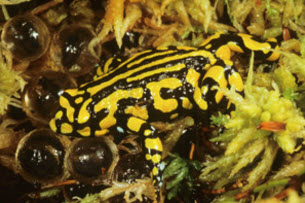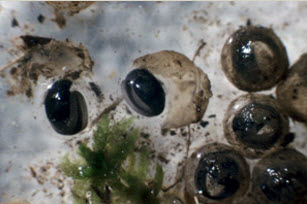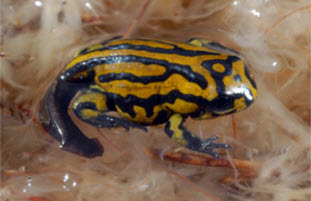Corroboree Frogs have a typical amphibian life-cycle with an aquatic tadpole stage and terrestrial frog stage.
Adult males move into breeding areas in early to late summer. The males make small chambers or nests in moss or other soft vegetation and soil at the edges of the breeding pools. Males have a special courtship call to attract the females to their nest to mate and lay their eggs. Typically, the pools are dry during the breeding season when the eggs are laid.
The male will remain in his nest through the breeding season and may accumulate many clutches from different females. Clutch size for Corroboree Frogs is relatively low for a frog species; 16 to 38 eggs per female.
Within the nest, the eggs develop to an advanced stage, before development stops and they enter what is called ‘diapause’. This means that the embryos remain, without developing further, until flooding of the nest following autumn or winter rains stimulates them to hatch.

Southern Corroboree Frog male in nest with eggs

Corroboree Frog eggs ready to hatch

Metamorphosing Southern Corroboree Frog
After hatching, the tadpoles move out of the nest site and into the adjacent pool where they live for the remainder of the larval period as a free swimming and feeding tadpole. Corroboree Frog tadpoles are dark in colour, have a relatively long paddle shaped tail, and grow to 30 mm in total length. The tadpoles continue growing slowly, particularly over winter when the pool may be covered with snow and ice, until metamorphosis in early summer.
The majority of southern Corroboree Frogs don’t reach reproductive age until four years from metamorphosis, although a small proportion of individuals reach sexual maturity in three years. Age to maturity for the Northern Corroboree Frog varies depending on the altitude of the population, with males from low altitude populations taking two years and males from high altitude sites taking four.
The males have two call types:
- advertisement or courtship call – to attract females to lay eggs in their nests
- threat call – warn other frogs of danger

